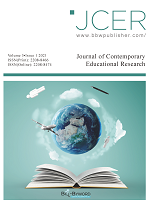Abstract
This article discusses a case study that explores the relationship between 21st century learning and curriculum alignment. It investigates three compulsory subjects: Chinese, mathematics, and English. By inquiring the survey on individual perspectives on curriculum content and authentic assessment in different schools within the scope of western Chinese primary schools, this article concluded that 21st century learning skills are well developed in primary schools. Although authentic assessment from parents’ perspective is diminutive, it is progressive for some students. Numerous factors can influence the actual practice of authentic assessment as teachers and pedagogies significantly contribute to students’ learning outcomes. The authentic assessment in China still has a long way to go in order to boost these learning skills to a higher level.
References
Hayhoe R, 2019, Contemporary Chinese Education, Routledge, 47-64.
Yin D, 2020, A Policy Review on Chinese Compulsory Education Quality Assessment: What We Learned from Official Reports Released in 2018 and 2019. ECNU Review of Education, : 1-14. https://doi.org/10.1177/2096531120944522
Trilling B, Fadel C, 2009, 21st Century Skills, Enhanced Edition: Learning for Life in Our Times, John Wiley & Sons, 3-19.
Heitink MC, Van der Kleij FM, Veldkamp BP, et al., 2016, A Systematic Review of Prerequisites for Implementing Assessment for Learning in Classroom Practice. Educational Research Review, 17: 50-62. https://doi.org/10.1016/j.edurev.2015.12.002
Huang F, 2004, Curriculum Reform in Contemporary China: Seven Goals and Six Strategies. Journal of Curriculum Studies, 36(1): 101-115. https://doi.org/10.1080/002202703200004742000174126
Fook CY, Sidhu GK, 2010, Authentic Assessment and Pedagogical Strategies in Higher Education. Journal of Social Sciences, 6(2): 153-161.
Voogt J, Roblin NP, 2012, A Comparative Analysis of International Frameworks for 21st Century Competences: Implications for National Curriculum Policies. Journal of Curriculum Studies, 44(3): 299-321. https://doi.org/10.1080/00220272.2012.668938
Cronin JF, 1993, Four Misconceptions About Authentic Learning. Educational Leadership, 50(7): 78-80.
Gulikers JT, Bastiaens TJ, Kirschner PA, 2004, A Five-Dimensional Framework for Authentic Assessment. Educational Technology Research and Development, 52(3): 67.
Frey BB, Schmitt VL, Allen JP, 2012, Defining Authentic Classroom Assessment. Defining Authentic Classroom Assessment, 17(2):1-18. https://doi.org/https://doi.org/10.7275/sxbs-0829
Ministry of Education of the People’s Republic of China, 2019, The Textbook Compiled by the Ministry Was Launched in September and Was “Praised” by More Than 90% of Students. http://www.moe.gov.cn/fbh/live/2019/51084/mtbd/201908/t20190828_396253.html
Curdt C, Xiao L, 2021, Environmental Literacy: Raising Awareness Through Chinese Primary Education Textbooks. Language. Culture and Curriculum, 34(2): 147-162.
Liu X, Lu K, 2008, Student Performance and Family Socioeconomic Status: Results from a Survey of Compulsory Education in Western China. Chinese Education & Society, 41(5): 70-83. https://doi.org/10.2753/CED1061-1932410505
Ministry of Education of the People’s Republic of China, 2019, Textbooks of Compulsory Education (Mathematics), People’s Education Press.
Georgetown University Math C, 1997, Dances with Calculators. Math Horizons, 5(1): 23-27. http://www.jstor.org/stable/25678124
Ministry of Education of the People’s Republic of China, 2019, Textbooks of Compulsory Education (English), Shaanxi Travel Press.
Riley KL, Stern BS, 1998, Using Authentic Assessment and Qualitative Methodology to Bridge Theory and Practice. The Educational Forum, 62: 178-185.
Wiggins G, 1990, The Case for Authentic Assessment. Practical Assessment, Research & Evaluation, 2(2): 1-3. https://doi.org/https://doi.org/10.7275/ffb1-mm19
Hammond LD, 2012, Policy Frameworks for New Assessments, in Assessment and Teaching of 21st Century Skills, Springer, 301-309.
Kippers WB, Wolterinck CH, Schildkamp K, et al., 2018, Teachers’ Views on the Use of Assessment for Learning and Data-Based Decision Making in Classroom Practice. Teaching and Teacher Education, 75: 199-213. https://www.journals.elsevier.com/teaching-and-teacher-education
Linda DH, Jon S, 2000, Authentic Assessment of Teaching in Context. Teaching and Teacher Education, 16(5): 523-545. https://doi.org/https://doi.org/10.1016/S0742-051X(00)00015-9
Wiggins G, 1991, Teaching to the (Authentic) Test, in Costa A, Developing Minds, A Resource Book for Teaching Thinking, Asociación Para La Supervisión Del Desarrollo Del Curriculum, ASCD, USA, 1, 344-350.
